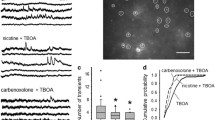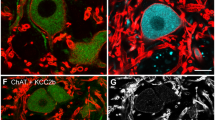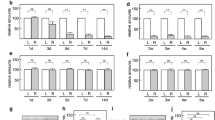Abstract
Facial and hypoglossal nerves were resected unilaterally in a total of 108 rats. Rats were divided into two groups; one group received standard food pellets (placebo), the other received food pellets containing the Ca2+-blocking agent nimodipine. The expression of glial fibrillary acidic protein was examined in paraffin sections of the brainstem using light microscopical immunocytochemistry, and the degree of glial process ensheathment of the surviving neuronal perikarya in the hypoglossal and facial nuclei quantified on electron micrographs. Up to 28 days post-axotomy no differences in glial fibrillary acidic protein-immunoreactivity were observed between placebo and nimodipine-treated animals. By 42–days, glial fibrillary acid protein-immunoreactivity was stronger in the nimodipine treated animals and by 112 days, glial fibrillary acid protein-immunoreactive astrocytes occured only in nimodipine-treated animals. Thin astrocytic processes were seen to ensheath neurons in both placebo and nimodipine-treated animals. By 28 days post axotomy, lesioned neurons in nimodipine treated animals were covered by a mean of 2.6 (hypoglossal) and 2.9 (facial nucleus) astrocytic lamellae, compared with 1.7 lamellae in the placebo group. This relatively greater ensheathment of hypoglossal and facial neurons was maintained up to 112 days post-lesion, but reduced in the placebo-treated group to ∼ 1.4 lamellae. It is concluded that nimodipine enhances the formation of astrocytic lamellae on lesioned neurons and that this process may be associated with a protective role for activated astrocytes directed towards motoneurons suffering from permanent target-deprivation.
Similar content being viewed by others
References
ANGELOV, D. N., GUNKEL, A., STENNERT, E., & NEISS, W. F. (1993) Recovery of original nerve supply after hypoglossal-facial anastomosis causes permanent motoric hyperinnervation of the whiskerpad muscles in the rat. Journal of Comparative Neurology 338, 214-24.
ANGELOV, D. N., GUNKEL, A., STENNERT, E., & NEISS, W. F. (1995) Phagocytic microglia during delayed neuronal loss in the facial nucleus of the rat: time course of neuronofugal migration of brain macrophages. Glia 13, 113-29.
ANGELOV, D. N., NEISS, W. F., STREPPEL, M., ANDERMAHR, J., MADER, K. & STENNERT, E. (1996a) Nimodipine accelerates axonal sprouting after surgical repair of rat facial nerve. Journal of Neuroscience 16, 1041-8.
ANGELOV, D. N., NEISS, W. F., STREPPEL, M., WALTHER, M., GUNTINAS-LICHIUS, O. & STENNERT, E. (1996b) ED2-positive perivascular cells act as neuronophages during delayed neuronal loss in the facial nucleus of the rat. Glia 16, 129-39.
BALLERINI, P., CICCARELLI, R., DIIORIO, P., GIULIANI, P. & CACIAGLI, F. (1995) Influence of Ca2] channel modulators on [3H]purine release from rat cultured glial cells. Neurochemical Research 20, 697-704.
BARRS, D. M. (1991) Facial nerve trauma: optimal timing for repair. Laryngoscope 101, 835-48.
BLINZINGER, K. & KREUTZBERG, G. (1968) Displacement of synaptic terminals from regenerating motoneurons by microglial cells. Zeitschrift für Zellforschung 85, 145-57.
BOONE, T. B. & ALDES, A. D. (1984) The ultrastructure of two distinct neuron populations in the hypoglossal nucleus of the rat.Experimental Brain Research 54, 321-6.
FINKBEINER, S. M. (1993) Glial calcium. Glia 9, 83-104.
GISPEN, W. H., SCHUURMAN, T. & TRABER, J. (1988) Nimodipine and neural plasticity in the peripheral nervous system of adult and aged rats. In The Ca 2+] Channel: Structure, Function and Implications (edited by MORAD, M., NAYLER, W., KAZDA, S. & SCHRAMM, M.) pp. 491-502. New York: Springer.
GOLDMAN, W. F., YAROWSKY, P. J., JUHASZOVA, M., KRUEGER, B. K. & BLAUSTEIN, M. P. (1994) Sodium/Calcium exchange in rat cortical astrocytes. Journal of Neuroscience 14, 5834-43.
GRAEBER, M. B. & KREUTZBERG, G. W. (1986) Astrocytes increase in glial fibrillary acidic protein during retrograde changes of facial motor neurons. Journal of Neurocytology 15, 363-73.
GRAEBER, M. B. & KREUTZBERG, G. W. (1988) Delayed astrocyte reaction following facial nerve axotomy. Journal of Neurocytology 17, 209-20.
GUNTINAS-LICHIUS, O., NEISS, W. F., GUNKEL, A. & STENNERT, E. (1994) Differences in glial, synaptic and motoneuron responses in the facial nucleus of the rat brainstem following facial nerve resection and nerve suture reanastomosis. European Archives of Otorhinolaryngology 251, 410-17.
GUNTINAS-LICHIUS, O., MARTINEZ-PORTILLO, F. J., SCHULTE, E., STENNERT, F. & NEISS, W. F. (1996) The influence of nimodipine on chromatolysis of motoneurons following axotomy with and without reinnervation: a quantitative image analysis. Neuroscience Research Communications, 19, 101-7.
HALL, L. L. & BORKE, R. C. (1988) A morphometric analysis of the somata and organelles of regenerating hypoglossal motoneurons from the rat. Journal of Neurocytology 17, 835-44.
HALL, L. L., BORKE, R. C. & ANDERS, J. J. (1989) Transection or electrical stimulation of the hypoglossal nerve increases glial fibrillary acidic protein immunoreactivity in the hypoglossal nucleus. Brain Research 490, 157-61.
HARRISON, B. C. & MOBLEY, P. L. (1992) Phosphorylation of glial fibrillary acidic protein and vimentin by cytoskeletal-associated intermediate filament protein kinase activity in astrocytes. Journal of Neurochemistry 58, 320-7.
HOLDAGO, A. & BEAUGE, L. (1995) The Na+-Ca2+] exchange in rat glial cells in culture: activation by external monovalent cations. Glia 14, 77-86.
LANGFORD, L. A. & COGGESHALL, R. E. (1980) The use of potassium ferricyanide in neural fixation. Anatomical Record 197, 297-303.
LITZINGER, M. F., FOSTER, G. & BRENNEMAN, D. E. (1986) [3H]-nitrendipine binding in non-neuronal cell cultures. Biochemical and Biophysical Research Communications 136, 783-88.
MARTINEZ-PORTILLO, F. J., GUNTINAS-LICHIUS, O., GUNKEL, A., STENNERT, E. & NEISS, W. F. (1993) Influence of nimodipine on astroglial response following axotomy of the facial or hypoglossal nerve in the rat. Annals of Anatomy Supplement 175, 200-1. (Abstract)
MUELLER, C. M. (1992) A role for glial cells in activitydependent central nervous plasticity? Review and hypothesis. International Review of Neurobiology 34, 215-81.
NEDERGAARD, M. (1994) Direct signaling from astrocytes to neurons in cultures of mammalian brain cells. Science 263, 1768-9.
NEISS, W. F., GUNTINAS-LICHIUS, O., ANGELOV, D. N., GUNKEL, A. & STENNERT, E. (1992) The hypoglossal-facial anastomosis as a model of neuronal plasticity in the rat. Annals of Anatomy 174, 419-33.
OH, T. H., MARKELONIS, J. M., VON VISGER, J. R., BAIK, B. & SHIPLEY, M. T. (1995) Acidic pH rapidly increases immunoreactivity of glial fibrillary acidic protein in cultured astrocytes. Glia 13, 319-22.
PORTER, J. T. & MCCARTHY, K. D. (1995) GFAP-positive hippocampal astrocytes in situ respond to glutamaterigic neuroligands with increases in [Ca2+]1. Glia 13, 101-12.
QUANDT, F. & MACVICAR, B. A. (1984) Ca2+ activated K+ channels in glials cells. Society for Neuroscience Abstracts 10, 939-45.
REISERT, I., WILDEMANN, G., GRAB, D. & PILGRIM, C. H. (1984) The glial reaction in the course of axon regeneration: a stereological study of the rat hypoglossal nucleus. Journal of Comparative Neurology 229, 121-8.
SALM, A. K. & MCCARTHY, K. D. (1989) Expression of beta-adrenergic receptors by astrocytes isolated from adult rat cortex. Glia 2, 346-52.
SHAO, Y. & MCCARTHY, K. D. (1995) Receptor-mediated calcium signals in astroglia: multiple receptors, common stores and all-or-nothing responses. Cell Calcium 17, 187-96.
TETZLAFF, W., GRAEBER, M. B., BISBY, M. A. & KREUTZBERG, G. W. (1988) Increased glial fibrillary acidic protein synthesis in astrocytes during retrograde reaction of the rat facial nucleus. Glia 1, 90-5.
TETZLAFF, W., LEONARD, C., KREKOSKI, C. A., PARHARD, I. M. & BISBY, M. A. (1996) Reductions in motoneuronal neurofilament synthesis by successive axotomies: A possible explanation for the conditioning lesion effect on axon regeneration. Experimental Neurology 139, 95-106.
VAN DER ZEE, C. E. E. M., SCHUURMAN, T., TRABER, J. & GISPEN, W. H. (1987) Oral administration of nimodipine accelerates functional recovery following peripheral nerve damage in the rat. Neuroscience Letters 83, 143-8.
VAN DER ZEE, C. E. E. M., BRAKKEE, J. H. & GISPEN, W. H. (1991) Putative neurotropic factors and functional recovery from periperal nerve damage in the rat. British Journal of Pharmacology 103, 1041-6.
WOFCHUK, S. T. & RODNIGHT, R. (1995) Age-dependent changes in the regulation by external calcium ions of the phosphorylation of glial fibrillary acidic protein in slices of rat hippocampus. Developmental Brain Research 85, 181-6.
Author information
Authors and Affiliations
Rights and permissions
About this article
Cite this article
Guntinas-Lichius, O., Martinez-Portillo, F., Lebek, J. et al. Nimodipine maintains in vivo the increase in GFAP and enhances the astroglial ensheathment of surviving motoneurons in the rat following permanent target deprivation. J Neurocytol 26, 241–248 (1997). https://doi.org/10.1023/A:1018592215557
Issue Date:
DOI: https://doi.org/10.1023/A:1018592215557




